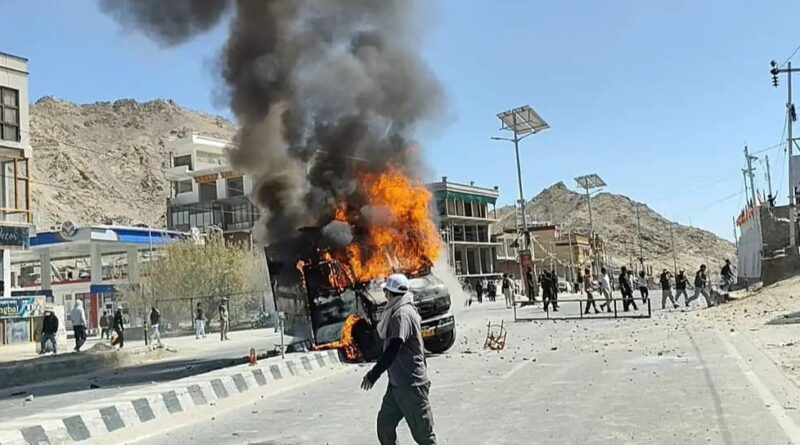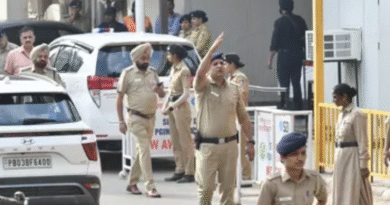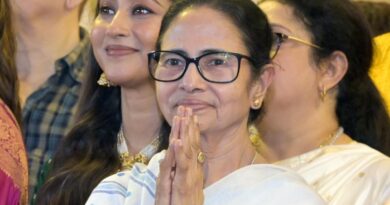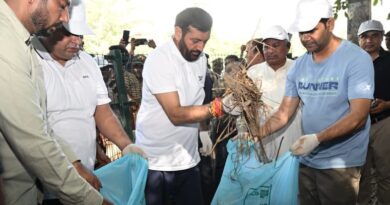Ladakh Protests Erupt into Deadly Chaos: Four Killed, Dozens Injured in Leh Clashes Over Statehood Demands
Activist Sonam Wangchuk ends 15-day hunger strike, decries ‘Gen-Z revolution’ of violence as BJP office and vehicles torched; curfew imposed amid fears of further unrest.
Leh: What began as a peaceful call for a complete shutdown in Leh spiraled into a night of fury and tragedy on Wednesday, as thousands of young protesters demanding full statehood for Ladakh clashed violently with security forces. At least four people lost their lives, with reports of police firing amid the mayhem, while over 70 others sustained injuries in the widespread unrest. The local administration swiftly imposed a strict curfew, prohibiting gatherings of more than five people, as flames engulfed the Bharatiya Janata Party (BJP) headquarters and multiple security vehicles.
The eruption of violence marked a stark departure from the non-violent ethos championed by prominent climate activist and education reformer Sonam Wangchuk, who had spearheaded a 15-day hunger strike alongside 14 others since September 10. Addressing a hastily convened press conference amid the chaos, Wangchuk announced the immediate suspension of the fast, his voice heavy with disappointment. “This was a Gen-Z revolution born of five years of unemployment and stolen democratic rights, but my message of peace has failed today,” he said, urging the youth to “stop this nonsense” before more lives are lost. “I’ve marched and fasted peacefully for years—violence only undermines our fight. I appeal to the government to heed our voices through dialogue, not force.”
The trigger for the shutdown was the hospitalization of two elderly hunger strikers—an 80-year-old woman and a man—on Tuesday evening, after their health deteriorated sharply after 35 days without food. Student unions and youth wings of the Leh Apex Body (LAB) mobilized swiftly, drawing crowds of schoolgirls, college students, and even monks to the streets in solidarity. What started as slogan-shouting marches toward the hunger strike site at the Hill Council building quickly escalated when protesters hurled stones and set fire to a Central Reserve Police Force (CRPF) vehicle stationed nearby.
Eyewitnesses described a scene of pandemonium: thick black smoke billowing from the BJP office as agitators breached barricades, while police and paramilitary troops responded with tear gas shells and baton charges to regain control. “The youth went out of hand after the news of the fainting elders spread like wildfire,” recounted local Congress leader Tsering Namgyal, who was present at the site. “There were hundreds of security personnel already deployed, but the crowd’s anger was overwhelming.” Videos circulating on social media captured protesters chanting “Statehood for Ladakh” and “Sixth Schedule Now,” interspersed with bursts of tear gas clouds and the acrid smell of burning rubber.
Casualty figures remain contested, with Wangchuk initially citing “three to five young deaths” from alleged police gunfire during a media briefing, though official sources later confirmed four fatalities and over 70 injuries, including to security personnel. Hospitals in Leh reported a surge in cases of pellet wounds, fractures, and respiratory issues from tear gas inhalation. The Union Territory administration, in a late-night statement, blamed “miscreants” for the arson and vowed a thorough probe, while ramping up deployments across Leh and Kargil districts.
At the heart of the agitation lies a deepening sense of betrayal among Ladakh’s predominantly tribal population—over 90% Scheduled Tribes—who celebrated the 2019 bifurcation from Jammu and Kashmir as a path to autonomy. The Jammu and Kashmir Reorganisation Act carved out Ladakh as a Union Territory without a legislature, placing it under direct central rule. Protesters argue this has eroded local protections, leading to fears over land rights, job losses to outsiders, and environmental degradation from unchecked development. Their core demands include: full statehood with a legislative assembly; inclusion under the Sixth Schedule for autonomous district councils; safeguards for tribal jobs and lands; a separate Public Service Commission; and two dedicated parliamentary seats for Leh and Kargil.
Wangchuk, a Ramon Magsaysay awardee and the real-life inspiration for the character in the film *3 Idiots*, has been a vocal face of the movement, framing it as a fight for cultural and ecological preservation in the fragile Himalayan region. Multiple rounds of talks between the LAB, Kargil Democratic Alliance, and the Centre have yielded promises but no concrete action, with the next dialogue slated for October 6— a date protesters want advanced amid the humanitarian toll of the strikes. “Peaceful protests aren’t yielding results; the youth feel cornered,” Wangchuk lamented, accusing the government of ignoring their pleas until desperation boils over.
The violence has drawn sharp reactions. National Conference leader Omar Abdullah expressed solidarity on X, drawing parallels to unfulfilled statehood pledges in Jammu and Kashmir: “Ladakh celebrated UT status in 2019 but now feels betrayed—imagine our pain in J&K.” Former Jammu and Kashmir DGP Sesh Paul Vaid called for calm, warning that “violence helps no one.” Meanwhile, Kargil announced a solidarity shutdown for Thursday, signaling the unrest’s potential spread.
As dawn broke over the snow-capped peaks on Thursday, Leh remained shrouded in tension, with schools and businesses shuttered under the curfew. For Ladakh’s youth—many jobless and disillusioned—the flames of Wednesday may have been doused, but the embers of their demands burn brighter than ever, demanding not just statehood, but a say in their destiny.




